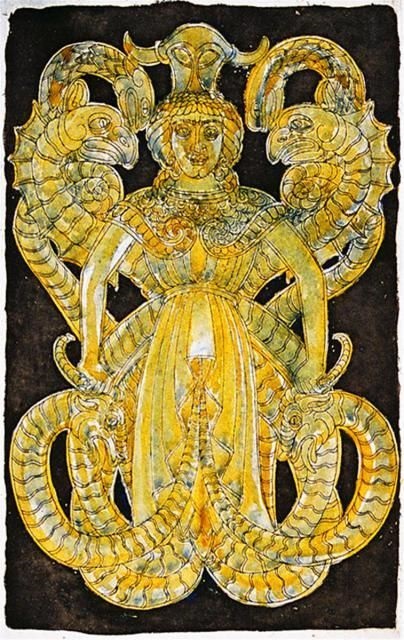Scythian Snake-Legged Goddess by unknown artist
"The Scythian echidna: From the fifth century BC historian Herodotus, we learn of a creature who, though Herodotus does not name as Echidna, is called an echidna ("she-viper") and resembles the Hesiodic Echidna in several respects. She was half woman half snake, lived in a cave, and was known as a mother figure, in this case, as the progenitor of the Scythians (rather than of monsters).
According to Herodotus, Greeks living in Pontus, a region on the southern coast of the Black Sea, told a story of an encounter between Heracles and this snaky creature. Heracles was driving the cattle of Geryones through what would later become Scythia, when one morning he awoke and discovered that his horses had disappeared. While searching for them, he "found in a cave a creature of double form that was half maiden and half serpent; above the buttocks she was a woman, below them a snake." She had the horses and promised to return them if Heracles would have sex with her. Heracles agreed and she had three sons by him: Agathyrsus, Gelonus and Scythes. She asked Heracles what she should do with his sons: "shall I keep them here (since I am queen of this country), or shall I send them away to you?" And Heracles gave her a bow and belt, and told her, that when the boys were grown, whichever would draw the bow and wear the belt, keep him and banish the others. The youngest son Scythes fulfilled the requirements and became the founder and eponym of the Scythians.
The Snake-Legged Goddess was associated to the life-giving principle. She appears in all variations of the Scythian genealogical myth as the Scythian fore-mother who sires the ancestor and first king of the Scythians with Dargatavah.
Her traits, consistent across the multiple versions of the genealogical myth, include her being the daughter of either a river-God or of the Earth and dwelling in a cave, as well as her being half-woman and half-snake. Diodōros of Sicily's description of this Goddess in his retelling of the genealogical myth as an “anguiped earth-born maiden” implies that she was a daughter of Api, likely through a river-God, and therefore was both chthonic and connected to water, but was however not identical with Api herself and instead belonged to a younger generation of deities of “lower status” who were more actively involved in human life.
The role of the Snake-Legged Goddess role as the foremother of the Scythians had been very firmly established in Scythian religion before the contacts with Mediterranean religions which influenced the cult of the Great Goddess Artimpasa to whom the Snake-Legged Goddess was affiliated.
Due to the influence of Levantine religions on the religion of the Scythians during their presence in the Near East, the Snake-Legged Goddess also bore a resemblance to the Levantine Goddess ʿAtarʿatah-Derketō in several aspects, including their monstrous bodies, fertility and vegetation symbolism, legends about their love affairs, and their respective affiliations and near-identification to Artimpasa and Aphroditē Ourania. Although the Snake-Legged Goddess was very closely identified to Artimpasa to the point of bordering on identification, the two goddesses were nevertheless distinct. Another influence might have been the Greco-Colchian Goddess Leukothea, whose mythology as a woman who was turned into a Goddess after throwing herself into the sea due to a curse from Hēra connects her to Derketō-ʿAtarʿatah, and whose sanctuary at Vani had columns crowned with female protomēs emerging from akanthos leaves similar to those of the Snake-Legged Goddess.
Reflecting influence from Levantine cults in which the Great Goddess was often accompanied by a minor semi-bestial Goddess, the Snake-Legged Goddess, who was also the Scythian foremother, was affiliated to Artimpasa. This affiliation was so close that the images of the two Goddesses would almost merge, but nevertheless remained distinct from each other. This distinctiveness is more clear in how Artimpasa was assigned the role of the king's sexual partner and the divine power of the kings who granted royal power, but was not considered the foremother of the people, and in how neither the Bosporan kings of Sarmatian ancestry nor the Graeco-Roman authors' records assigned Aphroditē or Artimpasa as the Scythians' ancestor."
-taken from wikipedia
 |
| Scythian Snake-Legged Goddess by unknown artist. |
Source:
Quote:


Comments
Post a Comment